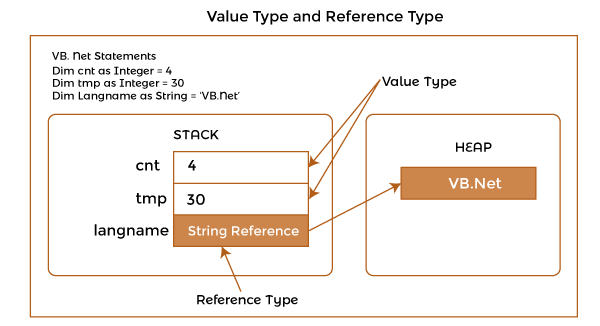.NET Common Language Runtime (CLR)
.NET CLR is a runtime environment that manages and executes the code written in any .NET programming language. CLR is the virtual machine component of the .NET framework. That language’s compiler compiles the source code of applications developed using .NET compliant languages into CLR’s intermediate language called MSIL, i.e., Microsoft intermediate language code. This code is platform-independent. It is comparable to byte code in java. Metadata is also generated during compilation and MSIL code and stored in a file known as the Manifest file. This metadata is generally about members and types required by CLR to execute MSIL code. A just-in-time compiler component of CLR converts MSIL code into native code of the machine. This code is platform-dependent. CLR manages memory, threads, exceptions, code execution, code safety, verification, and compilation.
The following figure shows the conversion of source code into native code.

The above figure converts code into native code, which the CPU can execute.
The main components of CLR are:
- Common type system
- Common language speciation
- Garbage Collector
- Just in Time Compiler
- Metadata and Assemblies
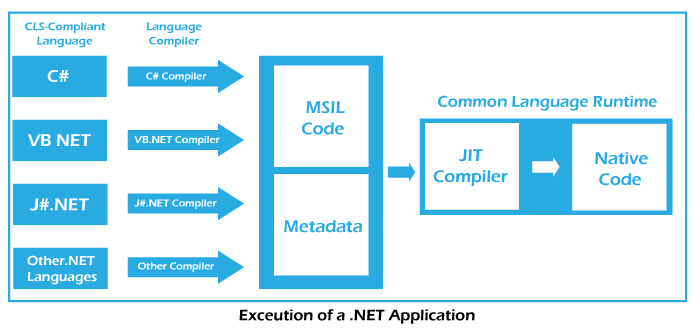
1. Common type system:
CTS provides guidelines for declaring, using, and managing data types at runtime. It offers cross-language communication. For example, VB.NET has an integer data type, and C# has an int data type for managing integers. After compilation, Int32 is used by both data types. So, CTS provides the data types using managed code. A common type system helps in writing language-independent code.
It provides two categories of Types.
- Value Type: A value type stores the data in memory allocated on the stack or inline in a structure. This category of Type holds the data directory. If one variable’s value is copied to another, both the variables store data independently. It can be of inbuilt-in types, user-defined, or enumerations types. Built-in types are primitive data types like numeric, Boolean, char, and date. Users in the source code create user-defined types. An enumeration refers to a set of enumerated values represented by labels but stored as a numeric type.
- Reference Type: A Reference type stores a reference to the value of a memory address and is allocated on the heap. Heap memory is used for dynamic memory allocation. Reference Type does not hold actual data directly but holds the address of data. Whenever a reference type object is made, it copies the address and not actual data. Therefore two variables will refer to the same data. If data of one Reference Type object is changed, the same is reflected for the other object. Reference types can be self-describing types, pointer types, or interference types. The self-describing types may be string, array, and class types that store metadata about themselves.
2. Common Language Specification (CLS):
Common Language Specification (CLS) contains a set of rules to be followed by all NET-supported languages. The common rules make it easy to implement language integration and help in cross-language inheritance and debugging. Each language supported by NET Framework has its own syntax rules. But CLS ensures interoperability among applications developed using NET languages.
3. Garbage Collection:
Garbage Collector is a component of CLR that works as an automatic memory manager. It helps manage memory by automatically allocating memory according to the requirement. It allocates heap memory to objects. When objects are not in use, it reclaims the memory allocated to them for future use. It also ensures the safety of objects by not allowing one object to use the content of another object.
4. Just in Time (JIT) Compiler:
JIT Compiler is an important component of CLR. It converts the MSIL code into native code (i.e., machine-specific code). The .NET program is compiled either explicitly or implicitly. The developer or programmer calls a particular compiler to compile the program in the explicit compilation. In implicit compilation, the program is compiled twice. The source code is compiled into Microsoft Intermediate Language (MSIL) during the first compilation process. The MSIL code is converted into native code in the second compilation process. This process is called JIT compilation. There are three types of JIT compilers -Pre, Econo, and Normal. Pre JIT Compiler compiles entire MSIL code into native code before execution. Econo JIT Compiler compiles only those parts of MSIL code required during execution and removes those parts that are not required anymore. Normal JIT Compiler also compiles only those parts of MSIL code required during execution but places them in cache for future use. It does not require recompilations of already used parts as they have been placed in cache memory.
5. Metadata:
A Metadata is a binary information about the program, either stored in a CLR Portable Executable file (PE) along with MSIL code or in the memory. During the execution of MSIL, metadata is also loaded into memory for proper interpretation of classes and related. Information used in code. So, metadata helps implement code in a language-neutral manner or achieve language interoperability.
6. Assemblies:
An assembly is a fundamental unit of physical code grouping. It consists of the assembly manifest, metadata, MSIL code, and a set of resources like image files. It is also considered a basic deployment unit, version control, reuse, security permissions, etc.
.NET CLR Functions
Following are the functions of the CLR.
- It converts the program into native code.
- Handles Exceptions
- Provides type-safety
- Memory management
- Provides security
- Improved performance
- Language independent
- Platform independent
- Garbage collection
- Provides language features such as inheritance, interfaces, and overloading for object-oriented programs.
The code that runs with CLR is called managed code, whereas the code outside the CLR is called unmanaged code. The CLR also provides an Interoperability layer, which allows both the managed and unmanaged codes to interoperate.
1. Managed code:
Any language that is written in the .NET framework is managed code. Managed code use CLR, which looks after your applications by managing memory, handling security, allowing cross-language debugging, etc. The process of managed code is shown in the figure:
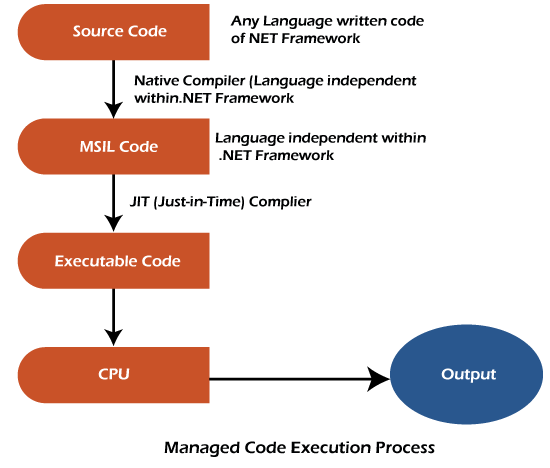
2. Unmanaged code:
The code developed outside the .NET framework is known as unmanaged code. Applications that do not run under the control of the CLR are said to be unmanaged. Certain languages such as C++ can be used to write such applications, such as low-level access functions of the operating system. Background compatibility with VB, ASP, and COM are examples of unmanaged code. This code is executed with the help of wrapper classes. The unmanaged code process is shown below:
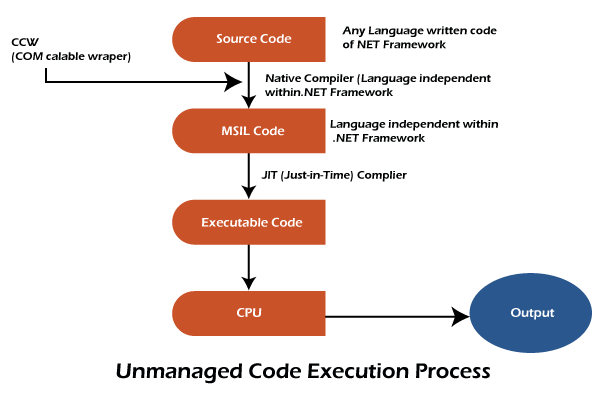
.NET CLR Versions
The CLR updates itself time to time to provide better performance.
| .NET version | CLR version |
|---|---|
| 1.0 | 1.0 |
| 1.1 | 1.1 |
| 2.0 | 2.0 |
| 3.0 | 2.0 |
| 3.5 | 2.0 |
| 4 | 4 |
| 4.5 | 4 |
| 4.6 | 4 |
| 4.6 | 4 |
.NET CLR Structure
Following is the component structure of Common Language Runtime.
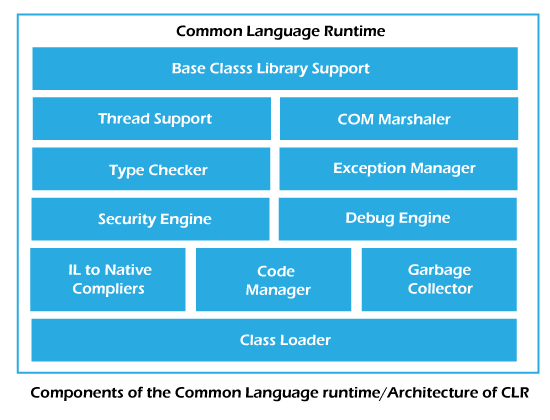
Base Class Library Support
It is a class library that supports classes for the .NET application.
Thread Support
It manages the parallel execution of the multi-threaded application.
COM Marshaler
It provides communication between the COM objects and the application.
Security Engine
It enforces security restrictions.
Debug Engine
It allows you to debug different kinds of applications.
Type Checker
It checks the types used in the application and verifies that they match the standards provided by the CLR.
Code Manager
It manages code at execution runtime.
Garbage Collector
It releases the unused memory and allocates it to a new application.
Exception Handler
It handles the exception at runtime to avoid application failure.
ClassLoader
It is used to load all classes at run time.

